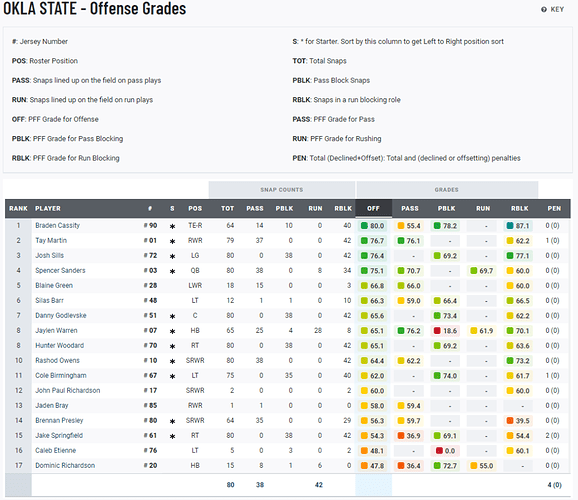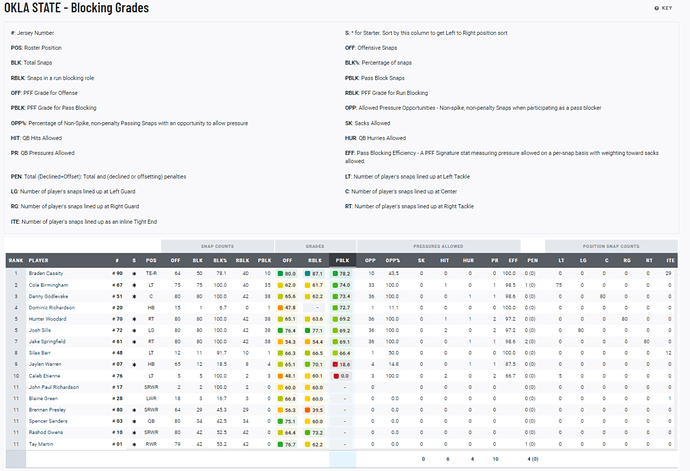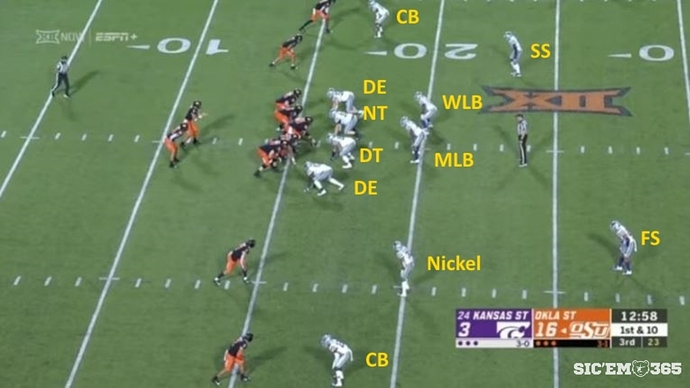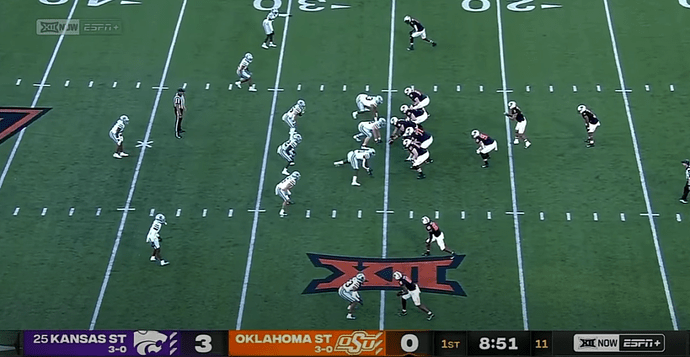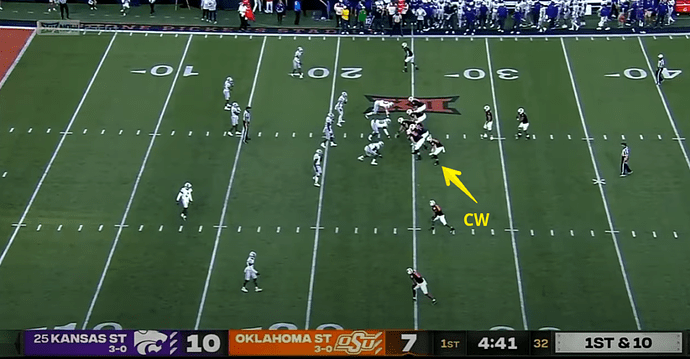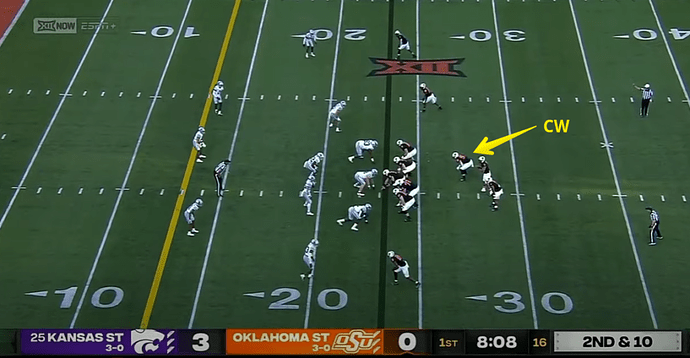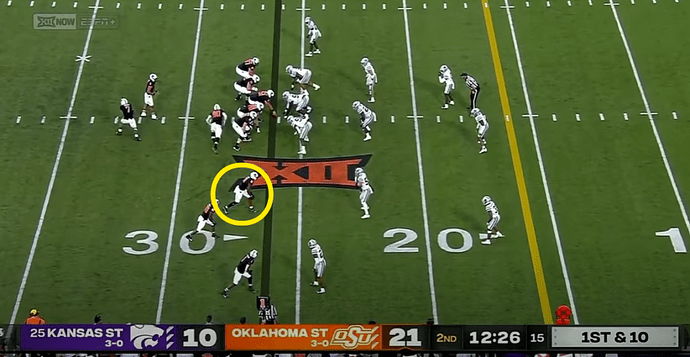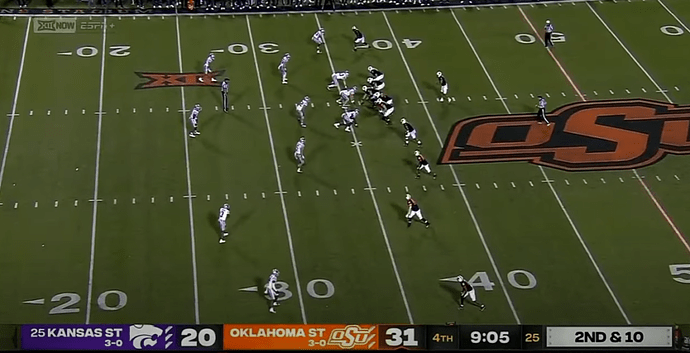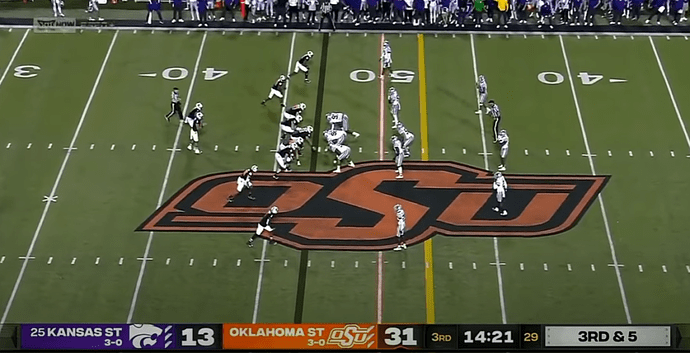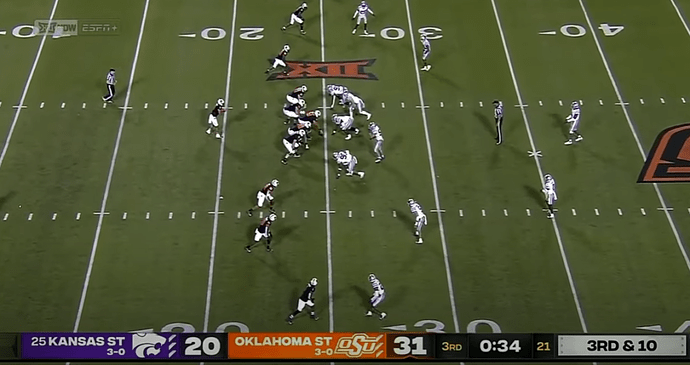Oklahoma State opened Big 12 play this past weekend with a 31-20 victory over Kansas State. Cowboy running back Jaylen Warren had another great game with 123 yards on 27 carries, and quarterback Spencer Sanders had a solid day through the air going 22-of-34 for 344 yards and two touchdowns. In addition, talented OSU wideout Tay Martin returned from injury and hauled in nine catches for 100 yards a one touchdown. The Cowboy offensive line saw week over week continuity for the first time all year, and it was very obvious that it was a huge positive for this unit. However, on the negative side of things, OSU was unable to score a point in the final two quarters for the second week in a row.
For Part 1 of this week's offensive film study, I'll take a look at the overall scheme and what the Pokes were trying to accomplish against the Wildcat defense on Saturday.
Personnel Groupings
Last week against BSU, with a lot of wide receivers banged up, offensive coordinator Kasey Dunn utilized multiple different personnel groupings, including a good chunk of two running back and multiple Cowboy Back sets. In addition, Dunn utilized his lowest percentage of 10 personnel, or four wide receiver sets, against the Broncos. But, with Martin, Blaine Green and Jaden Bray all back from injury, the Cowboys reverted back to more formations with three or more wide receivers. In fact, the Pokes went with three or more wide receivers on the field for 88% of their snaps against KSU, which is their highest percentage of the season.
Dunn also went completely away from 20 personnel, or two running back looks. Most likely due to not having a lot of depth and experience at running back with both LD Brown and Dezmon Jackson out with injuries.
Now let's take a look at the full game breakdown below. I'm counting 75 total plays, as I'm excluding the two kneels at the end of the game.
- 10 personnel: 20%
- 11 personnel: 68%
- 12 personnel: 12%
As you can see, the Pokes went heavy on their 11p formations. If you look at the first half alone, this percentage was even higher, as the Cowboys used their one Cowboy back, one running back and three receiver looks on 74% of their plays, including basing in 11 personnel on 14 of the first 15 plays of the game.
Now, let's take a look at the run/pass splits out of each grouping. For this set of statistics, I'm counting the lone sack as a passing play.
10 personnel
- Pass - 13 plays (86.7%)
- Run - 2 plays (13.3%)
11 personnel
- Pass - 21 plays (41.2%)
- Run - 30 plays (58.8%)
12 personnel
- Pass - 1 plays (11.1%)
- Run - 8 plays (88.9%)
Lastly, let's look at the breakout by yards gained.
- 10 personnel: 107 yards (7.1 yards per play)
- 11 personnel: 353 yards (6.9 yards per play)
- 12 personnel: 31 yards (3.4 yards per play)
PFF Grades
Before we get into the overall scheme, I wanted to give you a look at the Pro Football Focus Grades for the offense.
Overall Scheme
In regards to K-State's defensive scheme, head coach Chris Klieman and defensive coordinator Joe Klanderman have typically gone with a four-down front, and their previous base alignment is shown in the image below.
However, this season, including last weekend's match up with OSU, the Wildcats have based out of a three-down front, as you'll see in the following image. Their defense is set up somewhat similar to Iowa State's, and they had a lot of success with this new look up until their matchup with the Pokes.
In pass coverage, I saw KSU primarily drop into Cover 1, Cover 2, Cover 3 and Tampa 2, and it looked like some Quarters coverage was mixed in. Additionally, the Wildcats dialed up some blitz packages, but they weren't overly aggressive in that department.
From OSU's standpoint, it was obvious they wanted to attack K-State's defense with their Zone running game. Of their 40 rushing attempts, excluding the two kneel downs and the sack, 35 of them were some type of Zone run. In addition, after finding a lot of success with Split Zone against Boise State, OSU relied heavily on this concept last Saturday, running some variation of this play 21 times.
From a passing stand point, OSU gained a lot of yards with both running back and wide receiver screens. Sanders was 7-of-8 for 119 yards on screens, with the largest gains being attributed to Martin and Warren. The Pokes worked a fair amount of play action passes, and according to PFF Sanders was 11-of-16 for 188 yards on these throws. When the Wildcats were in man coverage, Martin was Sanders go-to guy, and he found Owens and Presley on several zone-beating routes for big gains. The Cowboy Backs also finally recorded some receptions, as Braden Cassity caught two passes for 14 yards.
As we discussed above, Oklahoma State based heavily out of 11 personnel. Dunn had the Cowboy back lined up at the H-back position, as you can see in the next image.
Or, in a fullback spot.
One interesting wrinkle Dunn added into the game plan this week out of 11p, was shifting the alignment of the Cowboy Back and running back pre-snap. See the example below.
Since the Cowboys were primarily running their Zone scheme, specifically Split Zone, shifting the Cowboy back and running back before the snap made it more difficult for the KSU defense to key on certain things and be able to tell pre-snap where OSU wanted to attack. Also, Dunn hasn't really utilized this movement yet this season, so K-State didn't have much, if any, film on this before the game to be able to figure out certain tells from the Cowboy offense.
Oklahoma State also used some interesting formations we haven't seen this year. For instance, in the image below, you'll see the circled receiver is actually ineligible as he's on the line of scrimmage (pointed out to me by random guy @AdamLunt). However, K-State still has a defender lined up over him, even though he can't catch a pass downfield.
The Pokes also showed this 4x1 wide receiver look out of 11p, which had both the Cowboy back and running back split out wide with two receivers to the same side of the field.
I'll talk more about this when I get into the passing game, but Dunn dialed up these unbalanced looks multiple times and found success.
In 10 personnel, the Cowboys were mainly in 2x2 sets, with both wide splits and tight splits, shown in the following two images.
The 2x2 tight formation is another wrinkle Dunn added in for this game, as we haven't seen it much yet this season.
Dunn also went with the 3x2, five wide receiver set.
When running 12p, the Cowboys didn't go the Diamond formation once, which is a pretty rare occurrence. Dunn stuck with one Cowboy back at H-back and one at tight end the majority of the time.
Conclusion
The first half of this game was schemed and executed beautifully by Oklahoma State. The Cowboys didn't do a lot of different things in the running game, as they mostly stuck with the Zone scheme, but the way they shifted the backfield pre-snap, utilized unbalanced formations and threw in some wide receiver motion really made things difficult for the K-State defense. Additionally, the offensive line blocked well in the running game, including Cowboy back Braden Cassity, as he followed up his performance against BSU with another solid outing. Warren also showed that his big game against the Broncos wasn't a fluke, and that he's one of the most elusive rushers in the country (fourth in missed tackles forced, according to PFF).
Through the air, Sanders had his best game of the year. There were two drops that I counted, PFF has three as they are counting one of Presley's that would've been a tough catch, so if you take those out, Sanders' completion percentage was nearly 70%. He also had to throw two balls away due to pressure. That being said, you're looking at only seven to eight incompletions depending on how you count the drops. PFF only has him with one turnover worthy play, and he's now gone two games without turning the ball over at all. But, he still needs to make decisions a little more quickly and he needs to continue to improve his vision in the running game, but overall I thought he played really well.
Having Martin back was huge. When Sanders needed some yards, Martin was the guy he went to. He knows how to get open in both man and zone coverage, and the additional attention the defense pays to him allows the other receivers more room to operate. The other young receivers had nice performances as well.
Now, the second half didn't go as well for the OSU offense, but a lot of this is due to the Cowboys having five offensive penalties for 49 yards in the final two quarters. I also have to give the KSU defense credit as they made some adjustments and didn't let the Cowboys get very much going in the rushing department. The O-line really struggled to get to the second level like they were in the first half, and Dominic Richardson and Warren were stopped for a lot of short gains.
Dunn has to figure out a way to keep the offense firing for the entire game, or the Pokes might lose some conference games in the fourth quarter. Although, I'm pretty happy with what I've seen from him scheme-wise these past two wins.
Next up, I'll go into further detail on the Cowboy rushing attack in Part 2.
